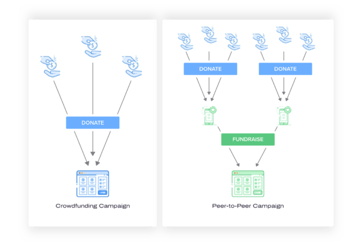Crowdfunding for charities vs. Peer-to-peer fundraising: What’s the difference?
At first glance, Peer-to-Peer and Crowdfunding do not seem to be so different. In fact, Peer-to-Peer fundraising is often considered to be a type of Crowdfunding.
After all, both are collaborative fundraising campaigns. They both rely heavily on social media and sharing to succeed. Nevertheless, the goals of each one and the opportunities to implement them in your fundraising strategy are very different.

Let’s take a look at the cases where you should use:
as well as some examples of particularly well adapted campaigns adapted in each situation.
Crowdfunding for charities
 Crowdfunding campaigns are appeals for donations targeted to your supporters. They are generally oriented towards a specific project to be financed. The renovation of a hospital for example, or even the funding of new equipment, or a specific campaign like GivingTuesday.
Crowdfunding campaigns are appeals for donations targeted to your supporters. They are generally oriented towards a specific project to be financed. The renovation of a hospital for example, or even the funding of new equipment, or a specific campaign like GivingTuesday.
Whatever the objective of the campaign, the important thing to remember is that in Crowdfunding, the action requested from your supporters is to make a donation.
Donation Incentives
 A very interesting element that is distinct to this type of fundraising are the incentives you can offer to your donors in exchange for their support. Your not-for-profit organisation can propose different donation amounts, and attribute a specific reward in exchange for that donation.
A very interesting element that is distinct to this type of fundraising are the incentives you can offer to your donors in exchange for their support. Your not-for-profit organisation can propose different donation amounts, and attribute a specific reward in exchange for that donation.
Rewards can consist of:
- goodies with your organisation’s branding,
- recognition in the form of publicly thanking your donors,
- nameplates within your establishment, like within your museum for example,
- to physical experiences like entry tickets for your establishment or tickets for an event that you are organizing.
The latter was the case of one of our clients, the Philharmonie de Paris, who offered the possibility to attend a concert performed by their young apprentices if donors gave towards the financing of new instruments for their Demos project.
The Museum of Natural History in Paris for example, regularly organizes Crowdfunding campaigns to finance very targeted operations, such as the restoration of the Durfort mammoth or the acquisition of exceptional minerals for the museum.
The request is always the same: to make a donation for a project. This project was initiated by your team, and you control the communication and timing.
Show donors their impact
Crowdfunding campaigns are a powerful tool that show your supporters the actual impact of their donations. It is very important to set fundraising goals for your projects for your donors to see, and to provide updates on how close you are to achieving your objective. Using a progress bar is a good example.
Set concrete goals and describe the impact of each gift. For example, 30€ can help provide nourishing kits for 4 children. This gives your donors a great sense of accomplishment. When people have a clear view of what their money is going towards, it is very possible they will be inclined to give more.

Peer-to-Peer fundraising
Peer-to-peer fundraising is a multi-tiered form of crowdfunding that engages your supporters to raise money on your behalf.
Compared to traditional crowdfunding campaigns, peer-to-peer campaigns give your most dedicated supporters the power to create their own personal fundraising pages where they call upon their friends and family to donate to your cause. They can also rally friends to unify their fundraising efforts and create a team fundraising page.

So rather than just collecting donations from one group of individuals, peer-to-peer enables you to leverage your network’s network in order to expand your reach and increase donations.
This can have an exponential effect, with the opportunity to mobilise a wider audience since your fundraisers will spread awareness to reach their goal.
Types of Peer-to-Peer Fundraising
Peer-to-peer is very versatile with several types of campaigns or approaches. Campaigns can be time-based, such as a sporting event, or ongoing campaigns that last throughout the year.
The different types of campaigns are:
- Existing sporting events (like the Marathon de Paris),
- Dedicated events that your organisation creates (like the campaign created by WWF Sweden Cooking for Nature),
- Special occasions (birthdays, weddings, in-memory, etc.)
- and corporate partnerships (like this example of Louis Vuitton for Unicef).
A key benefit of peer-to-peer fundraising is the trust that your not-for-profit organization can gain. People trust their friends and family. You supporters make your mission and the message personal, speaking about your cause with their own words, and this changes everything. Peer-to-peer campaigns have a massive impact on the trust and confidence that future donors will have in your organisation.

The main objective of a Peer-to-Peer campaign is therefore different from a Crowdfunding campaign: it is to appeal to your supporters to raise funds on behalf of your organisation and not to make a donation directly.
The St Peter’s Foundation and Focus Ireland, for example, use iRaiser’s Peer-to-Peer platform for their fundraising events.
 Using another interesting strategy, the Danish Red Cross focuses its iRaiser Peer-to-Peer fundraising platform on campaigns with specific issues such as the war in Ukraine or the humanitarian situation in Afghanistan. The Red Cross invites its donor base and supporters to mobilise for a specific cause, whether they are individuals, celebrities or even companies.
Using another interesting strategy, the Danish Red Cross focuses its iRaiser Peer-to-Peer fundraising platform on campaigns with specific issues such as the war in Ukraine or the humanitarian situation in Afghanistan. The Red Cross invites its donor base and supporters to mobilise for a specific cause, whether they are individuals, celebrities or even companies.
In today’s digital fundraising world, Crowdfunding and Peer-to-Peer are two essential tools for developing a successful fundraising strategy. Each tool addresses particular issues. This enables you to divide and target various groups of supporters. It depends on why, how and to what extent they want to be involved with your charity.
Having a mix of fundraising approaches can lead to success for any charity by diversifying the sources of funding, reaching a wider audience, and ensuring a more stable and sustainable revenue stream.
Want to explore the world of crowdfunding? Read our article: the keys to a successful crowdfunding campaign!
